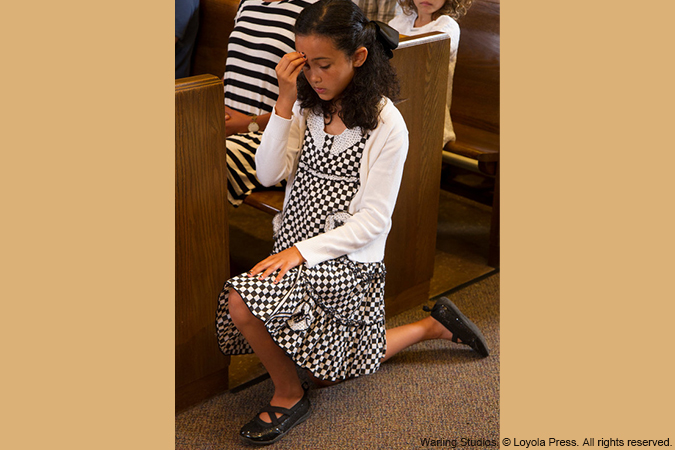
Church is where we celebrate our faith and receive our sacramental life. In our faith formation program, we either begin or end each catechetical session in the church, because we want to give the students a sense of belonging and help them become familiar with the ritual actions associated with Mass. By including some catechesis in the worship space, we can help children become active participants in the liturgy. Here are a few ways to incorporate the worship space into catechetical sessions.
Begin the year with a blessing at the baptismal font.
Teach students to pray the Sign of the Cross as they bless themselves with holy water. Connect doing this to how all of us were welcomed into the Church using those words during our Baptism. Older children or catechists by the font can help younger children learn the words and sequence of movements.
Explain the ritual actions we perform during the Mass.
When we enter the worship space, we genuflect or bow as a sign of respect for our God. We stand or kneel to pray, and we sit to listen. Connect these actions to everyday life. For instance, when guests come to our home, we greet them. What are our table manners during dinner with family and friends? Parents may talk with family members in the kitchen. Other times they might ask us to sit down and listen because something is important. Reinforce that while the ritual actions resemble the manners we might practice at home, they are much more than that—these actions help us express our devotion to God.
Practice the reception of the sacraments.
When preparing children to receive the sacraments for the first time, spend time in the worship space to make them feel comfortable. By practicing the elements of the rites in the actual space, children will be more comfortable when it is time for them to receive the sacraments. Sitting down in the pews and talking with Jesus quietly in our hearts and minds will reinforce that the sacraments are encounters with Christ. It is also a wonderful way to have a conversation with Our Lord any time we come into church.
Celebrate the Word of God.
Use the Scripture readings for the upcoming Sunday Mass. Involve children as readers and participants. Read the Word of God from the ambo, and introduce the readings as you would during the Liturgy of the Word. Invite people to respond with “Thanks be to God.”
Pray and explain the prayers of our Catholic tradition.
When we teach traditional Catholic prayers, we reinforce our common Catholic identity. We are one people in prayer. Explain the prayers by using the gestures that accompany them (ex. kneeling, the Sign of the Cross) and images found in the church (statues, stained-glass windows) to help children deepen their understanding of the faith. For example, when teaching the Lord’s Prayer, talk about when it is prayed during Mass.
Pray as a community.
Using the Prayers of the Faithful as a template, invite children to pray for the issues and people they care or worry about, including test time, upcoming games, or the victims of tragedies. Preschoolers often pray for their pets and parents. This helps children recognize that the Church is a community that prays for and with one another. If your parish has a book of intentions, let the children know about it and where it is.
Spending time for catechesis in the church can lead to grace-filled moments. Once, we had gathered in the church to pray. A young man prayed, “For my cousin and uncle who died in a fire on Christmas last year.” He had never included an intention for prayers before. The group gasped. It was obvious the young man’s friends did not know about this. The young teen’s eyes watered, and some of his friends reached out to him. I tried to pull the group together with “Lord, hear our prayer.” Then a catechist asked us to pray for a friend she lost. More students and catechists began to do the same. In the end, we put the names of all those we had lost in a jar and left it in the Blessed Sacrament chapel. It was a time of tears and shared life and loss that brought us together as God’s children.




Be the first to comment